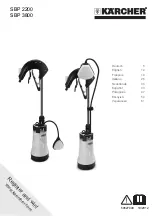
8
actual job.
Drive a test fastener with the air pressure set at 6.2 - 6.5
EDUSVL5DLVHRUORZHUWKHDLUSUHVVXUHWR¿QG
the lowest setting that will perform the job with consistent
results.
It may be possible to achieve the desired depth with air
SUHVVXUH DGMXVWPHQWV DORQH ,I ¿QHU DGMXVWPHQWV DUH
needed, use the drive depth adjustment on the tool.
DRIVE DEPTH ADJUSTMENT
6HH¿JXUH
The driving depth of the fastener may be adjusted. It
is advisable to test the depth on a scrap workpiece to
determine the required depth for the application.
7RGHWHUPLQHGHSWKRIGULYH¿UVWDGMXVWWKHDLUSUHVVXUH
and drive a test fastener. To achieve the desired depth,
use the drive depth adjustment on the tool.
1. Disconnect the tool from the air supply.
2. Turn the depth adjustment knob left or right to change
the driving depth.
3. Reconnect the tool to the air supply.
4. Drive a test fastener after each adjustment until the
desired depth is set.
REMOVING FASTENERS FROM THE TOOL
1. Disconnect the tool from the air supply.
WARNING
Disconnect the tool from the air supply and empty the
magazine before performing maintenance. Failure to do
so could result in serious personal injury.
2. Press down on the feeder cover latch and open the
feeder cover. Then open the magazine cover.
NOTE:
$OZD\V NHHS ¿QJHUV FOHDU RI IDVWHQHU WUDFN RI
magazine to prevent injury from unintended release of the
pusher.
3. Lift the nail strip from the spool and remove the
remaining coil of nails.
4. Close the magazine.
5. Securely close the feeder cover, snapping it into place.
Be sure that the feeder cover is locked.
CLEARING A JAMMED FASTENER
6HH¿JXUH
WARNING
Disconnect the tool from the air supply and empty the
magazine before clearing a jammed fastener. Failure to
do so could result in serious personal injury.
If a fastener becomes jammed in the tool, disconnect the
air hose and keep the tool pointed away from you while
clearing the jam.
1. Disconnect the tool from the air supply.
2. Open the feeder cover.
3. Remove fasteners from the tool.
4. Insert a rod into the driving mechanism. Tap the rod
with a hammer to push the driver mechanism back,
freeing the fastener jam.
5. Remove the bent fastener with a slotted screwdriver.
6. Reconnect the tool to the air supply.
7. Reinstall fasteners.
ATTACHING THE SCREW HANGER
6HH¿JXUH
1. Remove the rubber cap from the screw hole at the rear
of tool.
2. Attach the screw hanger to the rear of the tool. Tighten
the screw hanger by screwing it. (Tightening torque
range: 5.5-6.5 N.m)
MAINTENANCE
WARNING
When servicing use only identical replacement parts.
Use of any other parts may create a hazard or cause
product damage.
WARNING
Always wear eye protection with side shields marked to
comply with one of the following standards:
Ɣ
Australian Standard – AS/NZS 1337
Ɣ
European Standard – CE EN166
Ɣ
American Standard – ANSI Z87.1
Failure to do so could result in objects being thrown into
your eyes resulting in possible serious injury.
WARNING
Disconnect the tool from the air supply and empty the
magazine before performing maintenance. Failure to do
so could result in serious personal injury.
GENERAL MAINTENANCE
Avoid using solvents when cleaning plastic parts. Most
plastics are susceptible to damage from various types of
commercial solvents and may be damaged by their use.
Use clean cloths to remove dirt, dust, oil, grease, etc.
WARNING
'RQRWDWDQ\WLPHOHWEUDNHÀXLGVJDVROLQHSHWUROHXP
based products, penetrating oils, etc., come in contact
with plastic parts. Chemicals can damage, weaken or
destroy plastic which may result in serious personal
injury.


































